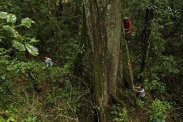Smithsonian Scientists Discover Tropical Tree Microbiome in Panama

Smithsonian scientists and colleagues working on Panama’s Barro Colorado Island discovered that small leaf samples from a single tree were home to more than 400 different kinds of bacteria. The combined sample from 57 tree species contained more than 7,000 different kinds.
Bacteria in tropical forests may also play a vital role, protecting leaves against pathogens and even affecting the ability of forests to respond to climate change.
“Just as people are realizing that microbes carried by humans can have an influence on a person’s health—positive or negative—we hope to discover what bacteria on tree leaves can tell us about the health of a forest,” said S. Joseph Wright, a Smithsonian scientist and co-author of the new study published in Proceedings of the National Academy of Sciences.
In contrast to a previous study of bacteria on leaves in a temperate forest where different leaves had different bacteria, there was a core group of species of common bacteria present on leaves of nearly all of the species sampled in Panama. Just as on human skin, many of the bacteria on tropical tree leaves were Actinobacteria and Proteobacteria.
The researchers, from the Smithsonian Tropical Research Institute, University of Quebec, University of Arizona, University of Oregon, University of California—Los Angeles and Santa Fe Institute, also looked for relationships between the composition of bacterial communities on leaves and other plant characteristics.
Many bacteria were associated with certain functional traits such as leaf thickness, wood density or leaf nitrogen content, characteristics that directly impact tree growth, survival and reproduction.
The relationships between many of the bacteria and tree species they sampled were ancient, going back to the ancestors of both the bacteria and the trees as they evolved in tandem.
“Our ability to use molecular techniques like 16S ribosomal RNA gene sequencing to characterize nearly all of the bacteria on a leaf is going to make it possible to see how very different members of forest communities interact,” said Wright. The Smithsonian forest ecologist and his colleagues hope to collaborate with researchers at the 60 Forest Global Earth Observatory sites coordinated by the Smithsonian’s Center for Tropical Forest Science to compare interactions at different sites and under different environmental conditions.
The Smithsonian Tropical Research Institute, headquartered in Panama City, Panama, is a unit of the Smithsonian Institution. The Institute furthers the understanding of tropical nature and its importance to human welfare, trains students to conduct research in the tropics and promotes conservation by increasing public awareness of the beauty and importance of tropical ecosystems. Website: www.stri.si.edu.
Kembel, S.W., O’Connor, T.K., Arnold, H.K., Hubbell, S.P., Wright, S.J. and Green, J.L. 2014 Relationships between phyllosphere bacterial communities and plant functional traits in a neotropical forest. Proc. Nat. Acad. Sci. early online edition: www.pnas.org/cgi/doi/10.1073/pnas.1216057111.
Media only
Beth King
+507 212-8216
kingb@si.edu
Sean Mattson
+507 212-8290
mattsons@si.edu
Media website
STRI News Releases
Media Contact
All latest news from the category: Agricultural and Forestry Science
Newest articles

High-energy-density aqueous battery based on halogen multi-electron transfer
Traditional non-aqueous lithium-ion batteries have a high energy density, but their safety is compromised due to the flammable organic electrolytes they utilize. Aqueous batteries use water as the solvent for…

First-ever combined heart pump and pig kidney transplant
…gives new hope to patient with terminal illness. Surgeons at NYU Langone Health performed the first-ever combined mechanical heart pump and gene-edited pig kidney transplant surgery in a 54-year-old woman…

Biophysics: Testing how well biomarkers work
LMU researchers have developed a method to determine how reliably target proteins can be labeled using super-resolution fluorescence microscopy. Modern microscopy techniques make it possible to examine the inner workings…





















